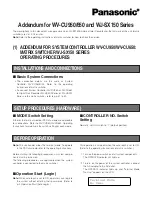
(Revised 2013-06-21)
50
Example of the Filters info screen (508FX2-A ONLY):
CLI\SWITCH\FILTERS>info
CLI\SWITCH\FILTERS>info
The General Broadcast filter is enabled now.
These ports receive General Broadcast: 1 2 3 4 5 6 7 8
N-Ring filter is Enabled. Ports 7 and 8 are ring ports.
600 series ring filter is Enabled. Ports 7 and 8 are ring ports.
There are no other Static Filters Active at this time.
There are no IGMP MultiCast Groups Active.
CLI\SWITCH\FILTERS>
Literally thousands of switches in one normal LAN can have N-View enabled without negative impact, but
one use of
sfilter
is related to reducing N-View related traffic from portions of LANs that include extremely
low bandwidth wireless links. The example above (with destination address
01-00-5E-01-01-00)
would filter
out N-View frames coming from other switches in the LAN. Using the configuration above, port 2 for
example would not get N-View frames from other switches in the LAN, but would get the few N-View
frames from the switch at hand. To stop those also, N-View can be disabled on the switch at hand.
How to acquire the IGMP snooping multicast group addresses for static entry:
(
One does not have to manually enter anything for this purpose
, unless accommodating non-IGMP
devices.)
(1) The entire 12 hexadecimal digits can be identified with a sniffer.
Or,
(2) The address can be calculated from a known class D address for the particular multicast session or
application.
Calculating the
IGMP snooping multicast group addresses:
First, the class D address must be known. While some of these class D addresses are well known (224.0.1.1
is used by NTP Network Time Protocol specified in RFC1119 for instance), the majority are defined when
the application is activated. Often, the class D address is the originating host computer’s IP address.
In most applications, the user has the option of choosing their multicast group address as a session is
established. The complete process of establishing IP multicast sessions is fully documented in RFC 1112
"Host Extensions for IP Multicasting" and the IGMP Version 2 RFC 2236. .
For the purposes of this document, only the process used to map a selected IP multicast class D address to a
specific MAC layer multicast destination address is significant.
Once an application determines the class D IP multicast address it will utilize, that address must be mapped
into a MAC layer multicast for delivery across any LAN based system. This process is outlined as follows:
Step 1: Using the Class D address, identify the low order 23 bits of the class D address.
















































